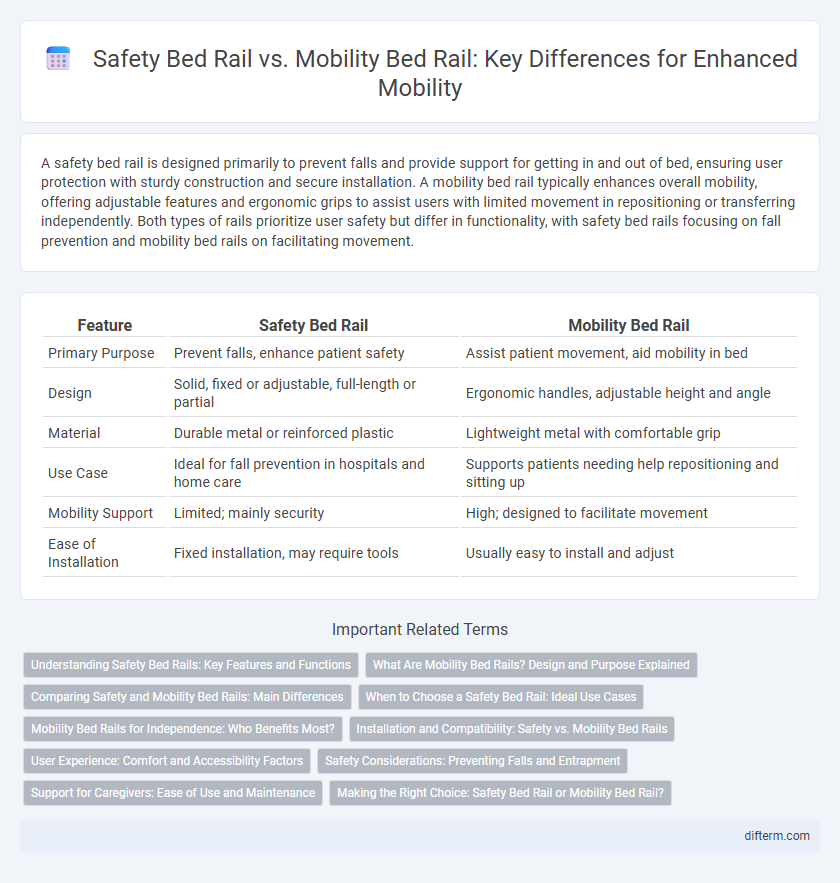A safety bed rail is designed primarily to prevent falls and provide support for getting in and out of bed, ensuring user protection with sturdy construction and secure installation. A mobility bed rail typically enhances overall mobility, offering adjustable features and ergonomic grips to assist users with limited movement in repositioning or transferring independently. Both types of rails prioritize user safety but differ in functionality, with safety bed rails focusing on fall prevention and mobility bed rails on facilitating movement.
Table of Comparison
| Feature | Safety Bed Rail | Mobility Bed Rail |
|---|---|---|
| Primary Purpose | Prevent falls, enhance patient safety | Assist patient movement, aid mobility in bed |
| Design | Solid, fixed or adjustable, full-length or partial | Ergonomic handles, adjustable height and angle |
| Material | Durable metal or reinforced plastic | Lightweight metal with comfortable grip |
| Use Case | Ideal for fall prevention in hospitals and home care | Supports patients needing help repositioning and sitting up |
| Mobility Support | Limited; mainly security | High; designed to facilitate movement |
| Ease of Installation | Fixed installation, may require tools | Usually easy to install and adjust |
Understanding Safety Bed Rails: Key Features and Functions
Safety bed rails are designed primarily to prevent falls and provide secure support for patients when getting in and out of bed, featuring sturdy construction, adjustable height, and enhanced padding. Mobility bed rails focus more on aiding movement and repositioning, often equipped with ergonomic handles and built-in mobility aids to assist users in shifting positions safely. Key functions of safety bed rails include minimizing injury risks, promoting patient independence, and ensuring compliance with health guidelines in clinical or home care settings.
What Are Mobility Bed Rails? Design and Purpose Explained
Mobility bed rails are specifically designed to assist individuals with limited mobility in safely entering, exiting, and repositioning themselves in bed, featuring adjustable height and length to accommodate various needs. Unlike traditional safety bed rails that primarily prevent falls, mobility bed rails incorporate ergonomic handles and stability features to enhance user independence and support physical therapy exercises. Their robust construction and user-friendly design improve daily mobility functions, reducing the risk of injury while promoting confidence and comfort.
Comparing Safety and Mobility Bed Rails: Main Differences
Safety bed rails prioritize preventing falls and injuries by providing sturdy, raised barriers, whereas mobility bed rails focus on enabling easier movement and support for getting in and out of bed. Safety rails are typically higher and more robust, designed to create a secure boundary, while mobility rails are lower and ergonomically shaped to assist with balance and leverage. Choosing between them depends on whether the primary need is fall prevention or enhanced mobility assistance.
When to Choose a Safety Bed Rail: Ideal Use Cases
Choosing a safety bed rail is essential for preventing falls and providing stability for individuals with limited mobility or those recovering from surgery, particularly in home care or hospital settings. Safety bed rails offer firm support and a secure barrier, making them ideal for elderly patients or individuals with balance issues during nighttime rest. They are best suited when the primary goal is fall prevention and enhanced safety rather than mobility assistance.
Mobility Bed Rails for Independence: Who Benefits Most?
Mobility bed rails enhance independence by providing stable support for individuals who need assistance with movement while minimizing restrictions on mobility. They are especially beneficial for older adults, people recovering from surgery, and those with limited strength or balance, enabling safer bed transfers and reducing fall risks. Unlike safety bed rails that primarily prevent falls, mobility bed rails promote active participation in movement, supporting autonomy and confidence in daily mobility tasks.
Installation and Compatibility: Safety vs. Mobility Bed Rails
Safety bed rails offer straightforward installation with adjustable clamps designed to fit most standard bed frames, ensuring secure attachment without tools. Mobility bed rails often feature modular designs compatible with various bed types, including hospital and adjustable beds, enabling customizable configurations to aid movement and transfers. Both types prioritize compatibility, but mobility rails emphasize adaptability for users requiring enhanced support during mobility tasks.
User Experience: Comfort and Accessibility Factors
Safety bed rails prioritize secure support to prevent falls, featuring cushioned padding that enhances user comfort during rest. Mobility bed rails emphasize ease of reach and adjustable height, allowing users to access the rail effortlessly for assistance when moving or getting in and out of bed. Both designs integrate ergonomic grips and smooth edges to optimize accessibility and reduce discomfort, catering to diverse mobility needs.
Safety Considerations: Preventing Falls and Entrapment
Safety bed rails are specifically designed with enhanced guardrails and padding to prevent falls and minimize entrapment risks, addressing critical concerns for elderly or disabled patients. Mobility bed rails prioritize ease of movement and transfer, often featuring adjustable heights and locking mechanisms to balance support with user independence. Selecting the appropriate bed rail requires evaluating individual mobility levels and safety needs to ensure optimal fall prevention and entrapment protection.
Support for Caregivers: Ease of Use and Maintenance
Safety bed rails offer caregivers enhanced stability and straightforward installation, reducing the risk of patient falls without complicated adjustment mechanisms. Mobility bed rails prioritize ergonomic designs that facilitate quick repositioning and transfer of patients, minimizing caregiver strain during daily use. Both types emphasize low-maintenance materials, but mobility bed rails often feature removable components for easier cleaning and durability in active care environments.
Making the Right Choice: Safety Bed Rail or Mobility Bed Rail?
Choosing between a safety bed rail and a mobility bed rail depends on individual needs, prioritizing either secure fall prevention or enhanced movement support. Safety bed rails offer sturdy barriers designed to prevent accidental falls during sleep, ideal for seniors or patients with limited mobility. Mobility bed rails provide ergonomic handholds that assist with standing or repositioning, promoting independence and ease of movement.
safety bed rail vs mobility bed rail Infographic

 difterm.com
difterm.com